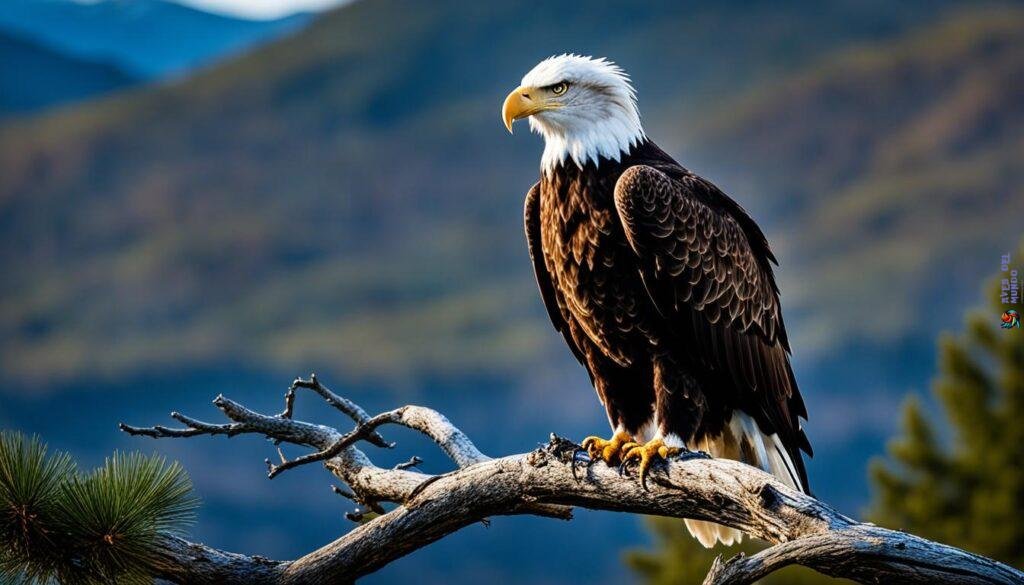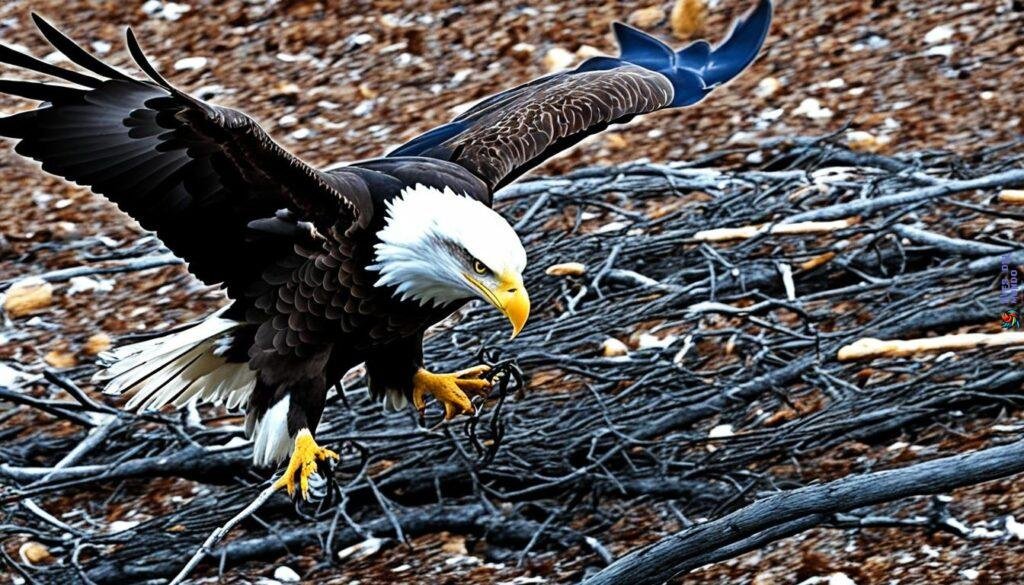Did you know that the bald eagle, the national bird of the United States, was once on the brink of extinction? These majestic birds, known for their iconic symbol status, faced a grave threat to their survival due to habitat destruction and hunting. But thanks to conservation efforts and legislation, the bald eagle population has made a remarkable recovery and is no longer considered endangered.
Habitat and Diet of the Bald Eagle
Bald eagles, majestic creatures that they are, primarily inhabit North America. You can find them in wooded areas near rivers, lakes, and other bodies of water brimming with life. Their choice of habitat provides them with ample opportunities to fulfill their dietary needs.
The diet of a bald eagle is varied and diverse. While fish account for a significant portion of their meals, these skilled predators also feast on birds, turtles, and small mammals. Their versatile palate allows them to adapt to different food sources, ensuring their survival in various environments.
When it comes to nesting, bald eagles are known to construct substantial structures. These nests can be found at the tops of trees, on cliffs, or even on the ground in treeless areas. Impressive in both size and weight, some nests can weigh up to 2,000 pounds!
Bald eagles display monogamous behavior, and they return to the same nest year after year, undisturbed by external factors, to breed and raise their young in a safe and familiar environment.

Notable Facts:
Bald eagles are skilled predators, adept at hunting both in the water and from the air.
Their impressive nesting structures can weigh up to 2,000 pounds.
Bald eagles exhibit monogamous behavior, returning to the same nest each year to breed and raise their young.
Conservation Status of the Bald Eagle
The bald eagle, once on the brink of extinction, has made a remarkable recovery thanks to dedicated conservation efforts. In the mid-1900s, the species faced significant challenges including hunting and habitat destruction, which led to a decline in their population. However, the introduction of the pesticide DDT further threatened their existence by weakening their eggshells, affecting their reproductive success.
In response to these alarming trends, conservationists and policymakers took action to protect the bald eagle. The banning of DDT and the implementation of the Endangered Species Act were key milestones in the species’ path to recovery. These measures played a crucial role in minimizing the threats and providing the necessary protection and support for their population to rebound.
As a result of these collective efforts, the bald eagle population has experienced a significant revival, leading to its removal from the endangered species list in 2007. This achievement highlights the success of conservation initiatives and serves as a testament to the resilience and adaptability of this majestic bird.
Conservation Milestones for the Bald Eagle
The following timeline showcases the major milestones in the conservation journey of the bald eagle:
| Year | Conservation Milestone |
|---|---|
| 1940s-1970s | Population decline due to hunting and habitat destruction. |
| 1972 | The use of DDT is banned in the United States. |
| 1973 | The Endangered Species Act is enacted, providing protection for the bald eagle. |
| 1995 | The bald eagle is downlisted from endangered to threatened status. |
| 2007 | The bald eagle is removed from the endangered species list. |
| 2017 | The bald eagle is delisted from the threatened species list, symbolizing a full recovery. |
The successful recovery of the bald eagle serves as an inspiration and a testament to the positive impact of dedicated conservation efforts. It underscores the importance of proactive measures in protecting and preserving our natural heritage and reminds us of our responsibility to safeguard endangered species for future generations.

Physical Characteristics of the Bald Eagle
The bald eagle, often referred to as the white-headed eagle, is a majestic bird known for its powerful presence and distinctive appearance. Despite its name, this iconic bird does not have a bald head. Instead, it boasts a striking white head and tail, which sets it apart from other species.
Females and males of the bald eagle species can have an impressive wingspan ranging from 7 to 8 feet. With their large wings and powerful muscles, they are adapted for soaring through the skies with grace and efficiency. These magnificent birds are naturally found only in North America, making them a truly unique and iconic symbol of the continent.
As juveniles, bald eagles have brown feathers, beaks, and eyes. However, as they mature, they develop the characteristic white head and tail feathers that define their appearance. This transformation is one of the most remarkable aspects of their life cycle.
The bald eagle possesses sharp talons that are perfectly suited for hunting and catching prey. With these formidable weapons, they can grasp and carry fish, birds, turtles, and small mammals with ease. Their incredible eyesight aids them in spotting prey from great distances, ensuring successful hunts.

Symbolism and Cultural Significance of the Bald Eagle
The bald eagle holds immense symbolism and cultural significance in American society. It has been associated with strength, power, and freedom since it first appeared on the Great Seal of the United States. The bald eagle is not only represented on official documents and currency, but it has also been featured in various forms of media, including comics and films. Its presence in the national consciousness reinforces its status as an iconic symbol of American pride.
The American eagle, often depicted with its majestic wings spread wide, has come to embody the values and ideals that the United States stands for. The eagle’s soaring flight represents freedom and independence, while its sharp eyes symbolize vision and insight. With its regal appearance and commanding presence, the bald eagle has become a lasting symbol of the American spirit.
| Symbolism of the Bald Eagle | Meaning |
|---|---|
| Strength | The bald eagle’s powerful physique and hunting prowess symbolize strength and resilience. |
| Power | Representing authority and dominance, the bald eagle is a visual embodiment of power. |
| Freedom | The eagle’s ability to soar through the skies freely represents the ideals of liberty and freedom. |
| Pride | The bald eagle’s prominent status as the national bird instills a sense of pride in Americans. |
In addition to its cultural significance, the bald eagle has a strong presence in American history and is deeply ingrained in the nation’s identity. It has been associated with important events such as the founding of the United States and the signing of the Declaration of Independence. The depiction of the bald eagle on the Great Seal of the United States signifies the importance of the bird as a symbol of the nation’s values and ideals.
Furthermore, the American eagle is often used during patriotic ceremonies, such as the inauguration of the President or the Fourth of July celebrations. Its image can be found on flags, emblems, and military insignias, further reinforcing its role as an enduring emblem of American pride and unity.
As a beloved and iconic symbol of the United States, the bald eagle continues to inspire awe and reverence. Its representation in various cultural mediums and its association with American values make it a significant and meaningful part of the nation’s heritage.

Threats to the Bald Eagle and Conservation Efforts
The bald eagle, despite its remarkable recovery, has faced several threats throughout its history. Habitat destruction, hunting, and the use of pesticides, such as DDT, have significantly impacted the population of these majestic birds. However, thanks to the Bald Eagle Protection Act and the banning of DDT, conservation efforts have played a crucial role in ensuring their survival and growth.
Habitat destruction poses a significant threat to the bald eagle population. As human activities, such as urbanization and deforestation, continue to encroach upon their natural habitats, these birds lose vital nesting sites and foraging grounds. Protecting and restoring their habitats is essential for maintaining healthy bald eagle populations. Conservation organizations and government agencies have implemented various strategies to mitigate habitat destruction, including the establishment of protected areas and the promotion of sustainable land use practices.
The historical hunting of bald eagles also posed a severe threat to their population. Once targeted for their feathers and perceived competition with livestock, they experienced a rapid decline. Fortunately, conservation efforts and legal protections have helped reduce hunting pressures on these birds. Today, it is illegal to harm or disturb bald eagles under the Bald and Golden Eagle Protection Act, enacted in 1940.
«The bald eagle is a symbol of the United States and an iconic species. It is our responsibility to protect and conserve their habitats to ensure their continued presence in our ecosystems.»
Pesticides, particularly DDT, had devastating effects on the bald eagle population. DDT was widely used in agriculture and inadvertently entered the food chain, affecting bald eagles and their reproductive abilities. Thin eggshells caused by DDT resulted in high nest failures and hindered population growth. The banning of DDT in 1972, coupled with intensive conservation efforts, led to the remarkable recovery of the bald eagle population.
Conservation organizations, researchers, and volunteers continue to monitor and protect bald eagles through ongoing conservation efforts. These efforts involve habitat restoration, public education, and ensuring breeding success by protecting nesting sites. Engaging local communities in conservation programs is fundamental in raising awareness about the importance of preserving these iconic birds and their habitats.

In summary, while habitat destruction, hunting, and pesticide use have threatened the bald eagle population in the past, conservation efforts have been instrumental in their recovery. By preserving and protecting their habitats, implementing legislation, and raising public awareness, we can ensure the continued survival and growth of this iconic bird species.
Interesting Facts about the Bald Eagle
The bald eagle, also known as the American eagle, is a bird with a rich history and several interesting facts associated with it. Let’s explore some captivating tidbits about this iconic species:
- Appearance in popular culture: The bald eagle has made appearances in various comic books, showcasing its majestic presence and symbolizing strength and freedom.
- Proudly featured on currency: The bald eagle has been prominently featured on United States currency and coins, symbolizing the nation’s pride and values.
- Associated with historic events: The bald eagle played a significant role during the Apollo 11 mission when the lunar module «Eagle» landed on the moon’s surface, solidifying its association with important moments in American history.
- A grand gathering: During salmon spawning season, bald eagles have been observed gathering in large numbers, with up to 4,000 birds congregating on a single riverbank, creating a spectacular sight to behold.
These captivating facts about the bald eagle highlight its cultural significance and further reinforce its status as a iconic symbol of American pride.
The Bald Eagle: A Symbol of American Identity
«The bald eagle represents the strength and resilience of the American spirit, reminding us of our shared values and the power of freedom.» – John Adams
Behavior and Characteristics of the Bald Eagle
Bald eagles exhibit fascinating behavior and possess unique characteristics that contribute to their iconic status. Their behavior is shaped by their territorial nature and remarkable hunting abilities. Here’s a closer look at some of their notable attributes:
Territorial Behavior
Bald eagles are highly territorial birds, establishing and defending their nesting territories. These territories can span several square miles and are fiercely protected. While they typically roam alone during the breeding season, during non-breeding times, bald eagles may form large roosting groups, where multiple individuals gather together in a communal setting to rest and socialize.
Distinctive Vocalizations
Bald eagles communicate through a wide array of vocalizations. Their distinctive calls serve various purposes, including establishing and defending their territory, attracting mates, and communicating with their offspring. These vocalizations range from high-pitched whistling sounds to low-frequency chattering calls.
Reverse Sexual Size Dimorphism
One of the striking characteristics of bald eagles is their reverse sexual size dimorphism, where females are notably larger than males. Female bald eagles have a wingspan that can reach up to 8 feet, while males generally have a wingspan of around 6 to 7 feet. This size difference is thought to be related to the roles played by each gender in breeding and nest defense.
Efficient Predators
Bald eagles are excellent hunters, equipped with adaptations that make them efficient predators. They have sharp, powerful talons capable of grasping and immobilizing prey, and their hooked beaks allow them to tear and consume their catch. Additionally, bald eagles possess exceptional eyesight, enabling them to spot prey from great distances while soaring high in the sky.
Visual representation
| Characteristic | Description |
|---|---|
| Territorial Behavior | Bald eagles are highly territorial, defending nesting territories and forming large roosting groups during non-breeding times. |
| Vocalizations | Bald eagles use distinct calls for various purposes, including defending territory, attracting mates, and communicating with offspring. |
| Reverse Sexual Size Dimorphism | Females are larger than males, with a wingspan of up to 8 feet compared to males’ 6 to 7 feet. |
| Efficient Predators | Bald eagles are skilled hunters with sharp talons, powerful beaks, and exceptional eyesight. |
Image:
Importance of Bald Eagle Conservation and Future Outlook
The conservation of the bald eagle is crucial for maintaining its population and preserving its cultural importance. As the national bird of the United States, the bald eagle represents the country’s values of strength, power, and freedom. To ensure the long-term survival of this iconic bird, it is essential to continue efforts in conservation.
Conservation measures should focus on protecting the habitats where bald eagles thrive. Preserving and restoring these environments, such as wooded areas near rivers and lakes, is vital for their nesting and hunting activities. By regulating hunting practices and preventing pollution, we can further safeguard the bald eagle’s well-being.
The success of previous conservation efforts provides hope for the future of the bald eagle. Thanks to initiatives like the Bald Eagle Protection Act and the banning of harmful pesticides, their population has made a remarkable recovery. Continued conservation efforts will be instrumental in ensuring the ongoing growth and prosperity of this majestic bird.
By recognizing the significance of bald eagle conservation and taking proactive steps, we can secure a brighter future for these magnificent creatures. The existence of the bald eagle serves as a reminder of the importance of protecting and preserving our natural environment for generations to come.



